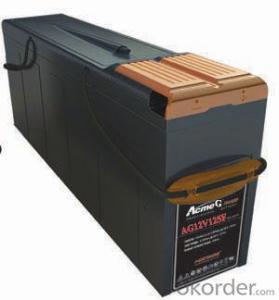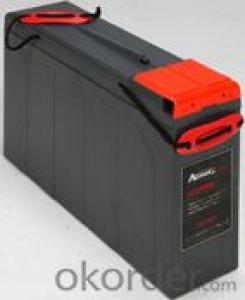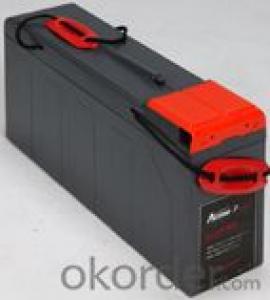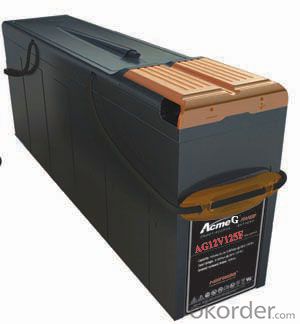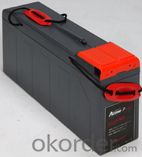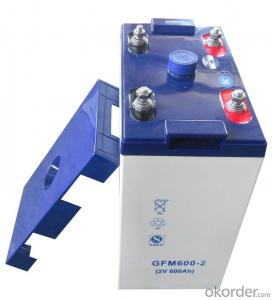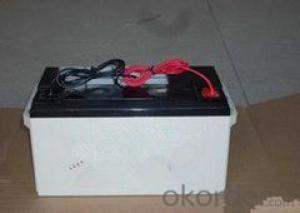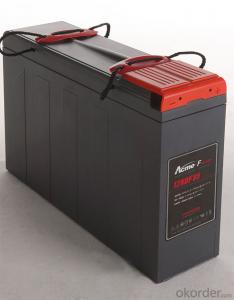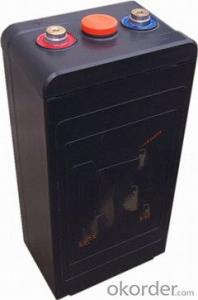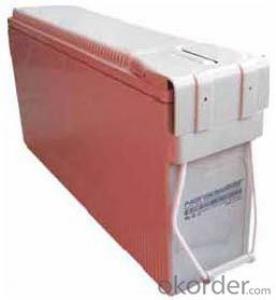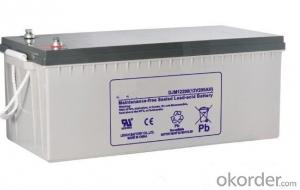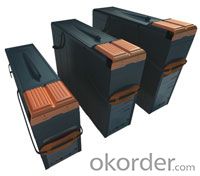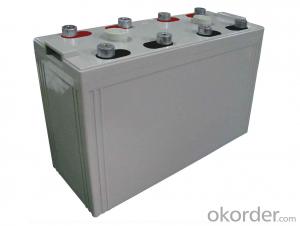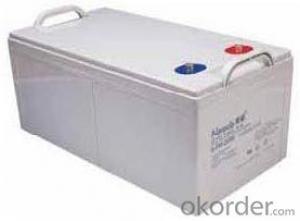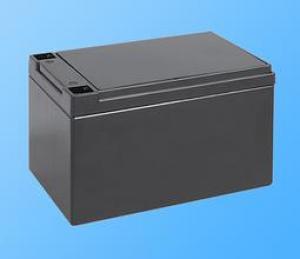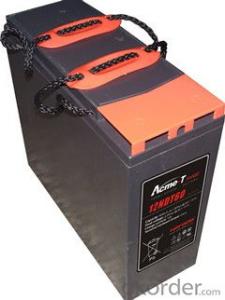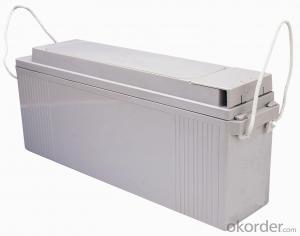Gel Battery the AcmeG Series Battery AG12V85F
- Loading Port:
- Shanghai
- Payment Terms:
- TT OR LC
- Min Order Qty:
- 2000 unit
- Supply Capability:
- 200000 unit/month
OKorder Service Pledge
OKorder Financial Service
You Might Also Like
Range summary
The AcmeG range front access gel batteries is designed based on the Acme series, using the polymer gel electrolyte with real front access structure. The state-of the-art internal and external design ensures AcmeG the high reliability and makes the installation quite simple and safe when placed on a standard relay rack tray or in a closed cabinet. AcmeG range gel battery is designed with high energy density and suitable for 19". 23" rack or cabinet.
Technical features
Long life
Using the polymer gel electrolyte
4BS paste technology
Special paste formula
Special patented grid alloyWide operational temperature range
Excellent charging and discharging ability at low temperature
Decline the water-loss at high temperaturespecial structure
real front access structure makes the installation and maintenance squite simple and safe
suitable for 19". 23" rack or cabinet
The specially centralized venting system ensures the small gas be vented our of the closed cabinet
Type: | AG12V85F | |
Voltage: | 12V | |
Nominal Capacity: | 85Ah(C10) | 85Ah(10 hours rate:) |
Length: | 390mm | |
Width: | 105mm | |
Height: | 270mm | |
Height with termial: | 270mm | |
Weight: | 31.5Kg |
Compliant standards
Designed to be compliant with:
IEC 60896-2
BS 6290 Part 4
Telcordia SR-4228
EUROBAT GUIDE
UL
Manufactured under system ISO9001 & ISO14001 by NARADA
Battery installation compliant with:
EN 50272-2 or local equivalents
Main applications
Telecom standby and cyclical applications
UPS
Power plant and power transfer system
Solar energy system
Emergency lighting system
Products characteristics:
float voltage: 2.25Vpc at 77oF(25oC) , Equalization charge voltage: 2.40Vpc at 77oF(25oC)
Self discharge rate: < 2% pre month at 68oF(20oC)
Design life: more than 12 years at 68oF(20oC)
Shelf life: 6 months at 68oF(20oC)
Recombination efficiency: >99%
the Pressure at which the valve opens & reclose is Opened at 10 to 35kpa(1.45psi to 5.08psi) and
closed at 3 to 15 kpa (0.44psi to 2.18psi)
Temperature ranges: -40oC to 50oC
Terminal Hardware Torque:10±0.1N m
Container Material: ABS (V0 optional)
FAQ
![]() What is a Gel Cell Battery?
What is a Gel Cell Battery?
A gel battery design is typically a modification of the standard lead acid automotive or marine battery. A gelling agent is added to the electrolyte to reduce movement inside the battery case. Many gel batteries also use one way valves in place of open vents, this helps the normal internal gasses to recombine back into water in the battery, reducing gassing. "Gel Cell" batteries are non-spillable even if they are broken. Gel cells must be charged at a lower voltage (C/20) than flooded or AGM to prevent excess gas from damaging the cells. Fast charging them on a conventional automotive charger may be permanently damage a Gel Battery.
![]() What is sulfation of batteries?
What is sulfation of batteries?
Sulfation is the formation or deposit of lead sulfate on the surface and in the pores of the active material of the batteries' lead plates. If the sulfation becomes excessive and forms large crystals on the plates, the battery will not operate efficiently and may not work at all. Common causes of battery sulfation are standing a long time in a discharged condition, operating at excessive temperatures, and prolonged under or over charging.
![]() How long a battery can last?
How long a battery can last?
The service design life of a battery are vary considerably with how it is used, how it is maintained and charged, temperature, and other factors.
![]() Do batteries self-discharge when not in use?
Do batteries self-discharge when not in use?
All batteries, regardless of their chemistry, self-discharge. The rate of self-discharge depends both on the type of battery and the storage temperature the batteries are exposed to. However, for a good estimate, Narada batteries self-discharge approximately 4% per week at 80ĄăF.
- Q: How is the capacity of the battery defined?
- General circuit has a battery protection circuit, once the battery voltage is less than 10.8V will automatically cut off the electricity to prevent the battery because of over-discharge and damage. (Nominal value of 12V battery internal six cell grid) with the battery discharge current multiplied by the discharge time to express how much energy the battery can store, is a very image of a measure. The greater the value of the battery, indicating that the battery can store more energy. But does not mean that the battery can use such a large current discharge.
- Q: What is the difference between a maintenance-free battery and a conventional battery?
- Different materials will produce a different phenomenon: the traditional battery in the course of the use of the phenomenon of liquid reduction occurs, because the antimony on the grid will pollute the sponge on the negative plate of pure lead, weakened after the full charge of the battery Electromotive force, resulting in excessive decomposition of water, a large number of oxygen and hydrogen, respectively, from the positive and negative plates to escape, so that the electrolyte reduced. With calcium instead of antimony, you can change the fully charged battery back electromotive force, reduce the overcharge current, liquid gasification rate decreases, thereby reducing the loss of electrolyte.
- Q: What are the technical parameters of the battery?
- Usually the capacity of the power supply is expressed by kV · A or kW. However, as a power supply VRLA battery, the use of security (A · h) that its capacity is more accurate.
- Q: How to deal with waste batteries?
- Laboratory recycling method: ordinary dry battery is cylindrical, the outer cylinder made of zinc, the zinc cylinder is the battery negative; tube central carbon rod for the positive; tube for the manganese dioxide, ammonium chloride and chlorination Zinc.
- Q: What are the hazards of battery over discharge?
- Crystalline conductivity is poor, and bulky, will clog the pores of the battery plate, affecting the battery electrolyte penetration and exchange, but also further increase the battery resistance, a long time will prevent the battery power and chemical energy Of the reversible conversion, resulting in poor recovery of the battery charge, the battery was seriously damaged, or even unable to repair until scrapped.
- Q: What battery does the van use?
- The battery is mainly composed of tube positive plate, negative plate, electrolyte, separator, battery compartment, battery cover, pole, injection liquid cover and so on. The electrode of the exhaust type battery is made of lead and lead oxide, and the electrolyte is an aqueous solution of sulfuric acid. The main advantage is the voltage stability, the price is cheap; the disadvantage is lower than the energy (that is, per kilogram of battery storage power), short life and routine maintenance frequently. Old ordinary battery life of about 2 years, and the need to regularly check the height of the electrolyte and add distilled water. However, with the development of science and technology, lead-acid battery life becomes longer and maintenance is also more simple.
- Q: What are the advantages of maintenance-free batteries?
- Maintenance-free battery because of its normal charging voltage, the electrolyte only produce a small amount of gas, so throughout the use of the need for the addition of distilled water, in the normal charging system, do not need to remove the charge from the removal. But in the maintenance of the proportion of its electrolyte should be checked.
- Q: How should the battery be well maintained?
- Battery Pile The battery pile head is part of the battery connected to the vehicle. If the corrosion or poor connection occurs, the battery will work poorly. The owner can check whether there is a white powder near the pile head, which is the sign of the pile head corrosion. If the white powder is more, you can use boiling water to burn it off, and then its anti-corrosion treatment, in the pile head smear some grease or preservatives can, but should not be too much to apply, so as not to affect the use.
- Q: What kind of battery is divided into?
- Ordinary battery: ordinary battery plate is composed of lead and lead oxide, the electrolyte is sulfuric acid aqueous solution. Its main advantage is the voltage stability, the price is cheap.
- Q: How does battery activation work?
- If you are talking about dry batteries, that is, to add sulfuric acid can use the battery (commonly known as water bottles), then it is because the long-term storage so that a high degree of oxidation of the negative board, plus acid will be a high temperature, Low, you can add acid in the pool after the addition of a small current for a long time to charge, you can solve. Generally with 0.05C charge to 3 times can be.
Send your message to us
Gel Battery the AcmeG Series Battery AG12V85F
- Loading Port:
- Shanghai
- Payment Terms:
- TT OR LC
- Min Order Qty:
- 2000 unit
- Supply Capability:
- 200000 unit/month
OKorder Service Pledge
OKorder Financial Service
Similar products
Hot products
Hot Searches
Related keywords

